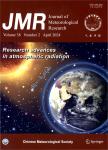Climate Sensitivity and Feedbacks of BCC-CSM to Idealized CO2 Forcing from CMIP5 to CMIP6
Climate Sensitivity and Feedbacks of BCC-CSM to Idealized CO2 Forcing from CMIP5 to CMIP6作者机构:National Climate CenterChina Meteorological AdministrationBeijing 100081 State Key Laboratory of Numerical Modeling for Atmospheric Sciences and Geophysical Fluid DynamicsInstitute of Atmospheric PhysicsChinese Academy of SciencesBeijing 100029 CAS Center for Excellence in Tibetan Plateau Earth SciencesChinese Academy of Sciences(CAS)Beijing 100101 Huafeng Meteorological Media GroupChina Meteorological AdministrationBeijing 100081
出 版 物:《Journal of Meteorological Research》 (气象学报(英文版))
年 卷 期:2020年第34卷第4期
页 面:865-878页
核心收录:
学科分类:07[理学] 0707[理学-海洋科学] 070601[理学-气象学] 070602[理学-大气物理学与大气环境] 0815[工学-水利工程] 0706[理学-大气科学] 0816[工学-测绘科学与技术] 0824[工学-船舶与海洋工程] 0825[工学-航空宇航科学与技术]
基 金:Supported by the National Key Research and Development Program of China (2016YFA0602602 and 2017YFA0603503) National Natural Science Foundation of China (41605057)
主 题:Beijing Climate Center Climate System Model(BCC-CSM) climate sensitivity cloud feedback sea icealbedo feedback Coupled Model Intercomparison Project Phase 6(CMIP6)
摘 要:Climate sensitivity represents the response of climate system to doubled CO2 concentration relative to the preindustrial level, which is one of the sources of uncertainty in climate projections. It is unclear how the climate sensitivity and feedbacks will change as a model system is upgraded from the Coupled Model Intercomparison Project Phase 5(CMIP5) to CMIP6. In this paper, we address this issue by comparing two versions of the Beijing Climate Center Climate System Model(BCC-CSM) participating in CMIP6 and CMIP5, i.e., BCC-CSM2-MR and BCC-CSM1.1 m,which have the same horizontal resolution but different physical parameterizations. The results show that the equilibrium climate sensitivity(ECS) of BCC-CSM slightly increases from CMIP5(2.94 K) to CMIP6(3.04 K). The small changes in the ECS result from compensation between decreased effective radiative forcing(ERF) and the increased net feedback. In contrast, the transient climate response(TCR) evidently decreases from 2.19 to 1.40 K, nearly the lower bound of the CMIP6 multimodel spread. The low TCR in BCC-CSM2-MR is mainly caused by the small ERF overly even though the ocean heat uptake(OHU) efficiency is substantially improved from that in BCC-CSM1.1 *** shortwave feedback(λSWCL) is found to be the major cause of the increased net feedback in BCC-CSM2-MR,mainly over the Southern Ocean. The strong positive λSWCL in BCC-CSM2-MR is coincidently related to the weakened sea ice-albedo feedback in the same region. This result is caused by reduced sea ice coverage simulated during the preindustrial cold season, which leads to reduced melting per 1-K global warming. As a result, in BCCCSM2-MR, reduced surface heat flux and strengthened static stability of the planetary boundary layer cause a decrease in low-level clouds and an increase in incident shortwave radiation. This study reveals the important compensation between λSWCL and sea ice-albedo feedback in the Southern Ocean.



